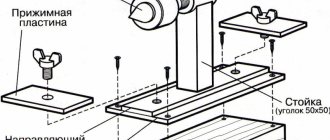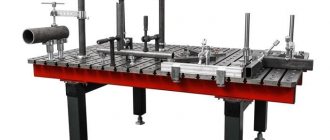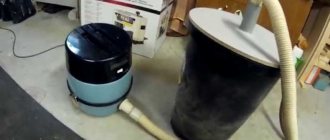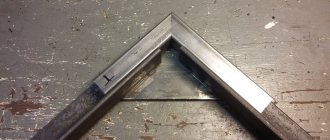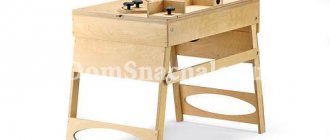08/31/2021 Author: VT-METALL
Issues discussed in the material:
- Basic requirements for a welding table
- Materials for welding table
- Dimensional drawings for welding tables
- An example of manufacturing a welding table from a profile pipe
- Ready-made drawings of a welding table for laser cutting
Drawings of a welding table will allow you to think through the dimensions and make the workplace as comfortable as possible for the welder, which will have a positive impact on the quality of the finished products. The main material for making the table is metal. Profile and perforated sheets can be used.
In addition to the dimensions of the table, the drawing allows you to think through additional details - take into account grounding, the location of the lighting, shelves for storing accessories, a waste tray and other elements. Read more about the types of welding table drawings in our material.
Requirements for a welding table
Before you start designing and manufacturing a welding table, you need to determine the requirements for it:
- Structural rigidity. It should not “walk” under the weight of massive or bulky welded structures.
- Reliability of workpiece fastening.
- Ease of operation for the welder.
- Shelves for welding equipment, welding materials.
- Box for rarely used tools.
In addition to the basic requirements, additional options can be provided:
- exhaust ventilation to remove welding gases;
- work area lighting - 36 volts or LED.
Welding table with lamp
In addition, it is important that flammable materials are not used.
Finishing
After making a practical and convenient welding table, you should worry about its appearance. It is best to paint the finished product with metal paint . This will not only decorate the table, but also extend its service life.
Tip : You can also increase the functionality of your workplace by making a folding table for the garage, a simple table made of boards or pallets, or a tool cabinet.
Required tools and materials
In a home workshop, they often try to make do with improvised materials. However, in order to meet the strength and stability requirements stated above, the following should be used for racks:
- profile with a cross-section of at least 60×60mm and a wall thickness of 4 mm;
- I-beam or angle 60×60, but already 4 mm thick.
The shelf and drawers can be made from a lighter profile.
Welding table drawing
The tabletop is assembled from rolled profiles. The gaps between them will be used to secure the parts to be welded with clamps or pliers.
For the protective screen use:
- base frame - light profile;
- the screen itself is a metal sheet 0.4-1.0 mm.
The protective screen also has side edges.
A welding table with a fastening system should be equipped with additional devices to help secure workpieces to the table and to each other:
- clamps;
- clamps;
- magnetic plate base for fastening small parts.
Welding table with clamping system
It is not possible to make this equipment for a welding table with your own hands; you will have to buy it.
Photo
Taking into account the tasks set, the materials used and creative impulses, you can even get the following results:
Welding table design
There are several types of designs. The most common:
- amateur, for occasional welding work, small structures by a home craftsman;
- semi-professional assembly and welding, for performing complex operations
For a table made from a profile pipe, made by yourself, the following dimensions are recommended:
- height of the working surface from the floor 70-85 cm;
- working surface dimensions of at least 80×100 cm;
- The height of the protective box is at least 140 cm from the floor.
Simple table for welding work
This design is durable, easy to manufacture, and convenient to use for small amounts of welding. It consists of a rigidly welded metal frame made of 60*60 profile. Four racks are attached to it. 20 cm from the floor they are connected by 20*20 corners. Tabletop elements are installed on top of the frame, forming a reliable support for the workpieces to be connected and equipped with grooves for their fastening.
Example of a mobile table
Hooks for wires from the welding machine are welded to the frame, and a shallow tray for scale and dust is placed under the working surface.
On one side of the welding table, a cabinet made of thin metal sheet is installed for storing small tools. Here I weld a stand for the water tank.
Semi-professional welding table
It is a welding and assembly station designed to improve the convenience of welding work. Allows you not only to cook, but also to carry out related mechanical processing.
This table includes:
- rotary working platforms;
- installation of drilling or milling equipment;
- quick-release bench vice;
- rotary attachments for attaching the welding machine;
- exhaust ventilation;
- flexible illumination of the working area;
- anchorage to concrete floor.
The purpose of all these improvements is to enable the welder to work from a comfortable, non-tiring position and to save time on the operation of removing and installing the product. Pays off for large volumes of work
How to choose?
Choosing the most suitable table for specific tasks is not so easy. After all, many factors have to be taken into account and it is possible that new circumstances may arise in the process of work. That is, if possible, it is necessary to provide for the maximum possible number of working moments.
Those who prefer comfortable working conditions and put them at the forefront should pay attention to round models of welding tables. They are usually rotating. Therefore, the entire range of problems (or most of them) can be solved without changing your location. Such equipment is mounted on a prepared concrete platform. If you plan to produce complex structures, you should choose a work surface with a set of additional equipment that would make it easier to complete the tasks.
Fortunately, manufacturers produce a wide range of welding tables and there really is plenty to choose from. Structures are often equipped with special equipment and equipment designed to perform highly specialized operations. And if you need universal equipment, then finding it will not take much time.
When choosing a welding table, experienced specialists advise paying attention to the following recommendations:
- The first step is to determine the optimal dimensions of the structure. They must meet production requirements and at the same time be comfortable for a specialist. If you lose sight of this point, welding work can become an unpleasant and even dangerous process.
- It is important that the work area is fenced. This is a kind of protective screen. It must be made of fire-resistant materials.
- The table should have a decent weight. At least 180-200 kilograms. Thanks to this, it will be rigid and quite stable.
- It is necessary to abandon energy-saving lamps. Their light creates glare, which is a source of discomfort while doing work.
- A big plus is the presence of a rotating platform. It is advisable to purchase just such models.
Sometimes the table lacks integrated ventilation. Then you definitely need to purchase it separately. As an option - a small exhaust device with magnets.
If it was not possible to choose something appropriate from the presented models, then you can order the manufacture of the structure according to individual drawings. Thanks to this approach, the owner will receive a welding table that will best meet his requirements. At the same time, you will not have to overpay for unnecessary functions or devices.
Comfortable working conditions cannot be created without the appropriate tools. You should pay special attention to his choice. It is important that fastening devices and clamps securely hold the workpieces in the desired position and make it possible to quickly change the position of the workpieces being connected.
When buying a table for a home workshop or small business, universal models are best suited. They are suitable for more than just welding work. On such surfaces you can fix a part for grinding, sharpening, drilling or performing any other technological operations.
Making a welding table
Let's take a closer look at the process of producing a simple welding table with your own hands. It is made of a rectangular metal profile and a corner. Dimensions can be changed depending on the needs of a particular home craftsman.
Let's decide on the size of the table
For free placement of workpieces, convenience and safety during work, we select the following sizes:
- height of the floor table top – 75 cm;
- tabletop dimensions – 80×100 cm;
- the height of the protective screen is 140 cm from the floor.
Preparation and cutting of material
To make the design you will need:
- corner 25×25, length 46 cm, ends cut at 45° – 4 pcs.;
- corner 25×225, length 76 cm, ends cut at 45° – 4 pcs.;
- profile 30×230×21.5, length 76 cm – 4 pcs. (for legs);
- steel sheet 3 mm 44.5×75 cm – 2 pcs. (for shelves);
- profile 60×240×22 mm – length 100 cm – 2 pcs.;
- profile 60×240×22 mm – length 72 cm – 2 pcs.;
- profile 40×230×21.5 length 72 cm – 8 pcs. ;
- swivel wheel support with stopper – 2 pcs.;
- wheel support – 2 pcs.
Welding table frame
The rolled product is cut with a grinder or a cutting saw and thoroughly cleaned of burrs.
Making a countertop
Along the contour, the tabletop is made from a 60×240 profile. When assembling, you should ensure that the angles and diagonals of the contour are equal.
The internal grille is assembled from sections of 30×230 profile and welded to the contour at equal distances from each other. All welds should be thoroughly cleaned with an angle grinder.
Welding table top
On the sides of the short sides, handles made of 8-12 mm rod can be welded to the bottom of the tabletop. This will allow you to move the table from place to place.
Table legs
The legs are welded at the corners of the tabletop frame. First, you should spot weld the legs and carefully check the angles of the legs with a charcoal and a metal ruler. They must be strictly perpendicular to the plane of the frame. If a skew is detected, it should be corrected. Otherwise the table will be unstable. Wheel mounts can be welded on the bottom of the legs. This is convenient if you plan to frequently move the table from place to place. If the place is permanent, then it is better to abandon the wheels that add instability and weld small squares of metal to increase stability and protect the floor from damage.
Table legs
After aligning the legs, they must be permanently welded and secured with additional strapping from light corners 20 cm from the ends. They are welded with the flat side down, and an OSB shelf is placed in the resulting recess. Welding equipment and materials, a mask, etc. are placed on it.
You can also weld several brackets and hooks to the legs for hanging cables, holders and other equipment. They are made from a steel bar of large nails. They should be thoroughly cleaned to remove any sharp edges.
Protective box
The protective box serves to prevent the scattering of splashes of molten metal during welding and solid waste during stripping. The frame is made from a lightweight corner, and the box itself is made from thin sheet metal. It is attached to the tabletop with pins. When working with parts that protrude beyond the dimensions of the table, the box is removed.
You can weld a tray with low sides under the tabletop to collect scale when cleaning seams. The tray is installed with a slight inclination so that debris gradually accumulates towards its lower edge.
Making a protective box
Tools are stored in a wooden or metal box. Instead, you can weld a cabinet with shelves.
Assembly
To carry out assembly work you will need:
- welding machine;
- electrodes;
- grinder with cutting disc and cleaning disc;
- a set of hand tools;
- ruler 1 m, corner, tape measure.
Assembly is carried out in the following order:
- cutting blanks, checking dimensions and angles according to the sketch drawing;
- tabletop assembly: first the outline, then the ribs;
- attaching legs;
- welding the bottom trim;
- fastening wheels or support platforms;
- assembly of the protective box;
- tray installation;
- final cleaning of seams, burrs and irregularities;
- applying primer and paint;
- installation of OSB sheet.
Additionally, you can weld handles for moving and hooks for wires.
Advantages of a specialized countertop
Having your own welding table in your garage or workshop allows you to carry out repair or installation work much faster.
The advantages of practical table selection include:
- Convenient and level area for work.
- Possibility of reliable fixation of objects, parts, assemblies, which ensures high precision of the welding seam.
- When fully equipped (the presence of brackets and lighting), even the slightest movements of the workpiece being processed are limited, which increases the accuracy of the welding seam.
- If there is a well-equipped ventilation system, the master has minimal contact with industrial dust and harmful compounds.
- Large countertops can have multiple functional areas to perform different tasks. If necessary, the welder has the ability to quickly switch to another type of activity.
The available tabletop height adjusters allow you to adapt the work area to the height of any craftsman.
